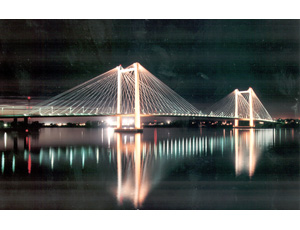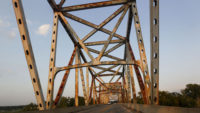

Arvid Grant, 93, a pioneer of modern concrete cable-stayed bridge engineering whose Columbia River span in Washington state was the longest such crossing in North America when it opened in 1978 and the first with a concrete deck, died on Jan. 18 in Olympia, Wash.
W. David Goodyear, a former associate who now is senior vice president at T.Y. Lin International, confirmed his death.
Grant’s Pasco-Kennewick Bridge design, with a 981-ft-long main span, was honored by President Ronald Reagan as “not just a great technical accomplishment. It is a work of art.”
Latvian-born Grant and the Olympia-based firm he founded, Arvid Grant & Associates, went on to design the East Huntington Bridge, between Ohio and West Virginia, in the early 1980s.
ENR cited him for that 900-ft span, saying its “hybrid concrete-and-steel bridge deck cut depth, weight and cost." The challenge also included a state requirement that the concrete span conform to the single-tower configuration of the steel design option.
“Arvid was a tremendously resourceful engineer and believed bridge engineering was a calling,” says Goodyear. “He began each design with a pencil and a blank sheet of paper, first crafting a vision of what the bridge design should be before the numbers constrained the image.”
He helped found the Structural Engineers Association of Washington and was a past president.
“Arvid was a tremendously resourceful engineer and became a self-taught surveyor and HVAC/mechanical engineer, adding to the bridge engineering talents needed to support his early private practice with local clients in Southwest Washington,” says Goodyear.
But he also was outspoken on key issues, such as the lack of creativity in U.S. bridge design and peers' criticisms of the cable-stayed design.
"American bridge engineers until 30 years ago were regarded everywhere as the most resourceful, imaginative and daring," Grant said in a 1977 ENR story. “Corporate-management artists that have taken over the construction industry and the trend is to make us all equal production workers, available to do the lowest price drafting work."
On the Washington state bridge, Grant oversaw construction management and directed the project's quality control program, according to the ENR article. He flew his own six-passenger airplane 112 miles each week from his company's office to the jobsite to inspect the work.
Grant also took issue with peers' later assertions in civil engineering publications and in the New York Times that cable-stayed spans in other global locations were prone to corrosion and metal fatigue.
''The public should not be misled with innuendoes, with conjectures,'' he told the Times. ''Don't confuse the European mistakes with life. Those are historical relics; they don't apply anymore.''





Post a comment to this article
Report Abusive Comment